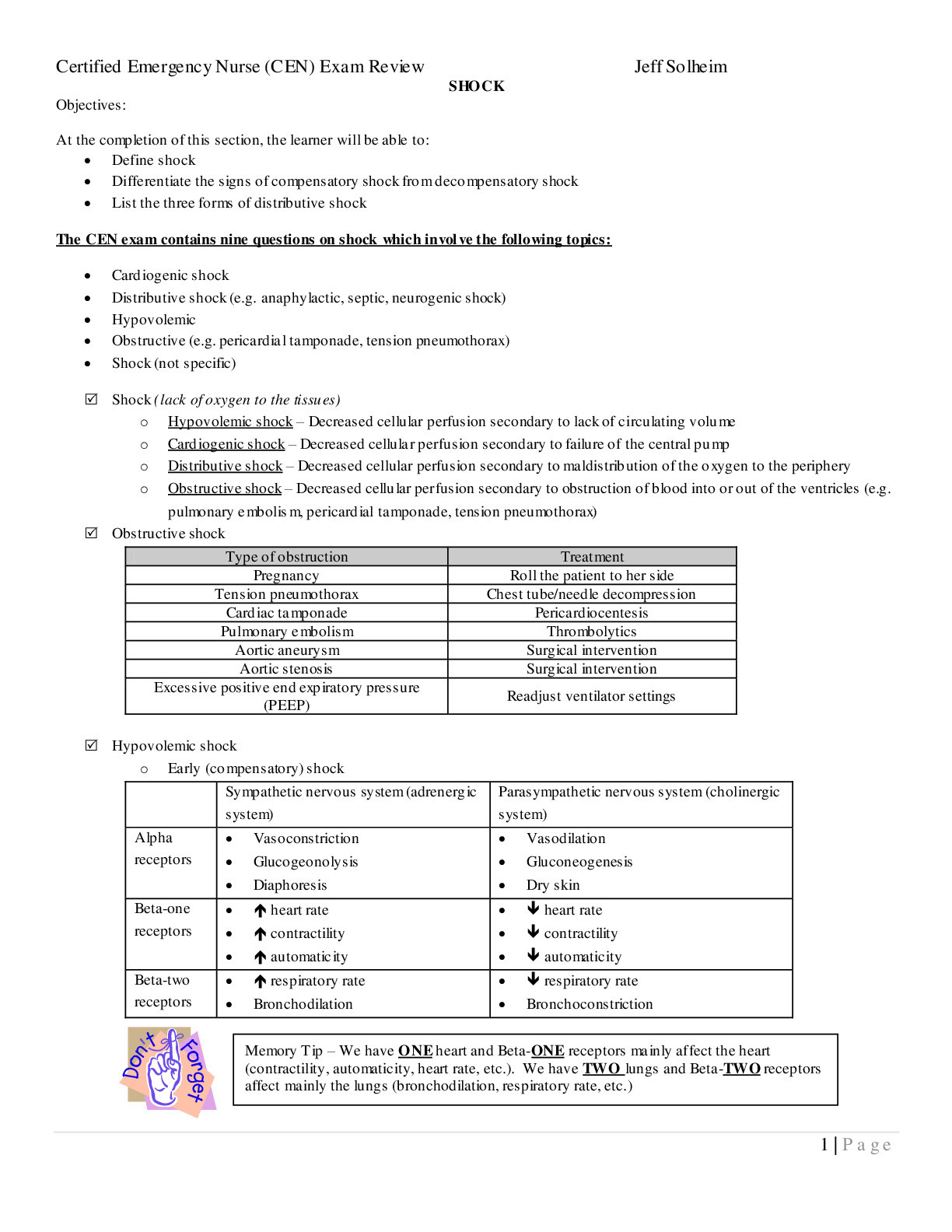All study resources > CEN1 Shock_Hematology (Nursing)
CEN1 Shock_Hematology
Objectives:
At the completion of this section, the learner will be able to:
Define shock
Differentiate the signs of compensatory shock from decompensatory shock
List the three forms of distributive shock
The CEN exam contains nine questions on shock which involve the following topics:
Cardiogenic shock
Distributive shock (e.g. anaphylactic, septic, neurogenic shock)
...[Show More]
Objectives:
At the completion of this section, the learner will be able to:
Define shock
Differentiate the signs of compensatory shock from decompensatory shock
List the three forms of distributive shock
The CEN exam contains nine questions on shock which involve the following topics:
Cardiogenic shock
Distributive shock (e.g. anaphylactic, septic, neurogenic shock)
Hypovolemic
Obstructive (e.g. pericardial tamponade, tension pneumothorax)
Shock (not specific)
Shock (lack of oxygen to the tissues)
o Hypovolemic shock – Decreased cellular perfusion secondary to lack of circulating volume
o Cardiogenic shock – Decreased cellular perfusion secondary to failure of the central pump
o Distributive shock – Decreased cellular perfusion secondary to maldistribution of the oxygen to the periphery
o Obstructive shock – Decreased cellular perfusion secondary to obstruction of blood into or out of the ventricles (e.g.
pulmonary embolism, pericardial tamponade, tension pneumothorax)
Obstructive shock
Type of obstruction Treatment
Pregnancy Roll the patient to her side
Tension pneumothorax Chest tube/needle decompression
Cardiac tamponade Pericardiocentesis
Pulmonary embolism Thrombolytics
Aortic aneurysm Surgical intervention
Aortic stenosis Surgical intervention
Excessive positive end expiratory pressure
(PEEP)
Readjust ventilator settings
Hypovolemic shock
o Early (compensatory) shock
Sympathetic nervous system (adrenergic
system)
Parasympathetic nervous system (cholinergic
system)
Alpha
receptors
Vasoconstriction
Glucogeonolysis
Diaphoresis
Vasodilation
Gluconeogenesis
Dry skin
Beta-one
receptors
heart rate
contractility
automaticity
heart rate
contractility
automaticity
Beta-two
receptors
respiratory rate
Bronchodilation
respiratory rate
Bronchoconstriction
Certified Emergency Nurse (CEN) Exam Review Jeff Solheim
2 | P a g e
Definition:
Agonist – St imulates a system
Antagonist – Diminishes the response of a system
Late (decompensatory shock
Inflammatory mediators are released in response to either foreign invasion of tissue or tissue damage. They
have three main courses of action:
Vasodilation
Increased capillary permeability
Increased coagulation
Clinical manifestations of shock
o Treatment
Fluid replacement
Crystalloids
o Isotonic crystalloids given at a 3:1 replacement ratio.
o Generally, a bolus of 1 – 2 liters of crystalloid solution is administered to a patient with
indications of hypovolemic shock.
o Pediatric patients are given boluses at a rate of 20 mL/kg.
[Show Less]
